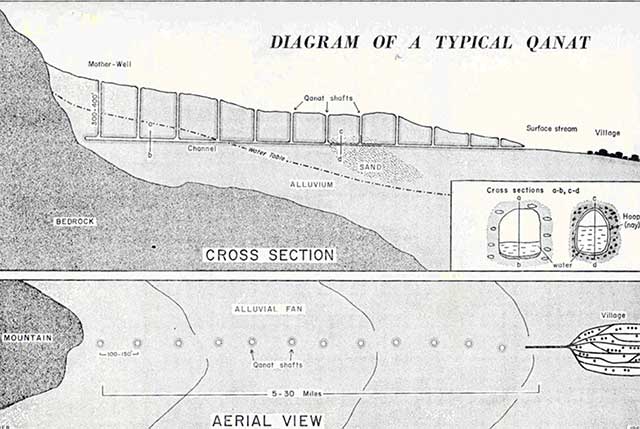|
|
In his royal proclamation Darius the Great
calls upon Ahura Mazda to bless his land and to deliver it from 3 ever
present menaces, ‘lies’, ‘external aggression,’ and ‘drought.’ Darius the
great realizing the importance of agriculture as a corner stone of
civilization and human progress focuses on promoting it throughout his
empire. A system of underground irrigation canals known as Qanat
is devised that is instrumental in turning the otherwise arid Iranian
plateau into the bread basket of the world. Borrowing the idea from
earlier civilizations - likely the Urartians - use of the similar system
of underground tunnels for mining, the Qanat allows tapped underground
water at the foot of mountains to flow and be delivered in the middle of
arid land often hundreds of miles away from its source, with minimum loss
to evaporation in hot desert like climate. The landscape of Eastern Near
East dotted with Qanats ever since that time bears witness to the
importance Zoroastrians and Iranians place on nurturing mother earth by
turning it green and keeping it fertile and agriculture rich.
[ii]

From the book, “City and Village in Iran –
Settlement and Economy in the Kerman Basin”, by Professor Paul W.
English, The university of Wisconsin Press, 1966
Darius and his successors were also
instrumental in having agricultural products native to one part of the
Empire planted in other parts helping diversify and improve local
agricultures. Alfalfa, abundant in Media (western Iran) was successfully
taken and planted in Greece to provide more nutritious forage for Persian
army there. The Persians introduced rice into Mesopotamia, pistachio into
Syria, sesame into Egypt.
The historians accompanying the invading army
of Alexander storming through Kerman province and central Iran report the
landscape being covered with forests and tall trees. Much of the same land
is now part of the Iranian desert. Negligence of agriculture in Post
Sassanian Iran resulting in deforestation has taken its toll on the land
that was once agriculture-rich and the envy of the world.
It is said few years after the fall of Iran to
Arabs in 7th century A.D., a member of the Sassanian royal
family was located and taken to the Arab ruler in shackles. Taking pity on
the man whose family’s fall from grace had given the Arab his prominence,
the new ruler asks him to name a reasonable favor to be granted to him. To
make the point for his ancestry, the captured Sassanian prince challenges
the Arab, ‘now that you are the overlord, ask your officials to travel the
length and width of this land and to find any vast stretch of earth that
is not green and fertile.’ ‘If such land is ever found, let me turn it
into fertile agricultural land.’
The Sasanians like the Parthians and the
Achaemdians before them valued and emphasized agriculture, and would
routinely reward the top producers.
In Islamic Iran, with most professional
opportunities denied to them, agriculture proved to be a viable means of
survival for many remaining Zarathushtis in Iran. Living in villages, and
away from cities that were fast becoming stronghold of Shia'ism by the
turn of the16th century many Zarathushtis were able to make a
living for themselves by cultivating the land. Some Zarathushtis of
Kerman forcedly moved to Isfahan by the Safavid Shah Abbas[iii]
were responsible in large part for the beautification of that city, the
lush gardens that earned the city the title ‘Isfahan, half the world’.
In the 18th and 19th
century for the Zoroastrians who were allowed to live in the cities of
Kerman or Yazd or the ones living in villages, fruit trees planted and
cared for in the house yards they had, served another practical use.
Often the access fruits born by the household trees or obtained elsewhere
would be dried in the court yards or on the roof tops and saved for use
during the winter months or for various religious functions and
gatherings. The grapes they grew would be used for making house wines for
family consumption on special occasions. A cup filled with wine would be
one of the item at Novruz table for Zoroastrian households.
Often the fruits grown by Zoroastrians and
villages had superior quality and would be prefaced by the title “Shah”
(Shah Miveheh, Shah Golabee – King pear, etc.).
Besides the fruits and the orchards that the
Zartoshty families grew in their homes, one tree that could be found in
most Zartoshty household was cypress (evergreen), the kind that grows in
Kerman and Yazd. The symbolism of the cypress of always staying green even
during the cold winter months - when other trees would lose their leaves -
must have had much to do with the Zoroastrian love affair with that tree.
Cypress’ longevity and its endurance under harsh natural conditions must
have also served as a source of inspiration to the Zarathushtis of Iran
enduring under very difficult conditions. Small branches of the cypress
would routinely be exchanged between Zoroastrians in Iran as a gesture of
good wishes on auspicious occasions.
With liberalization that came about in Iran in
the first part of the 20th century, the small remaining
community of Zoroastrians of Yazd and Kerman finding a more tolerant and
fair environment emerged as major agriculturalist well out of portion to
their small numbers.
Notably after the passage of 24 centuries
from the time of Darius the great whose Qanat systems had continued to be
in use, the pioneering of the new system of irrigation in 20th
century Iran was led by another visionary Zarathushti.
[iv]
[i]
This article was produced in July 2004 based on request from Dr. Sam
Kerr, guest editor of the Spring 2005 issue of the FEZANA journal,
under the theme ‘Vegetation on Earth’ for inclusion in that issue.
[ii]
Jim Hicks, “The Persians”, Time-Life Books, New York, 1975, pps.
77-82
[iii]
Ganj Ali Khan
[iv]
Esfandiar Bahram Yeganegi
|